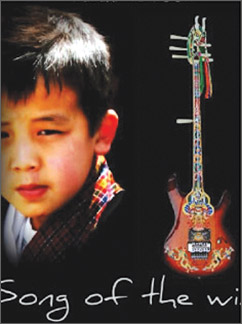An absorbing Bhutan film
by Kalakeerthi Edwin Ariyadasa
“The new cinema refuses to recognise
national boarders. It identifies itself as fiction nor as
documentary. Likewise, it is unconcerned with genre, which is useful
only to the agents of commerce.”
- Filmmaker Travis Wilkerson
When I started putting down my thoughts, about the latest in the
SAARC cinema series, I could not help but confront a slightly knothy
logistical dilemma. How do we provide a wider-scoped reception to these
intriguing films from the SAARC countries?
Isn't there any viable technique, that could be devised, to spread
the collective discourse delivered by these films, to enable closer
cultural cordiality among the SAARC brotherhood?
 When these films are screened, in a systematised program, they
invariably register a heightened impact. They cannot command the
identical kind of focussed attention, when they are shown at various
venues, where they cannot have a special presence. When these films are screened, in a systematised program, they
invariably register a heightened impact. They cannot command the
identical kind of focussed attention, when they are shown at various
venues, where they cannot have a special presence.
The monthly SAARC Film Day, institutionalised by the SAARC Cultural
Centre in Colombo, has elevated the selected films to a niche placement,
making them distinct objects of study.
Insights
Research scholars and experts in a whole range of disciplines, can
now concentrate on the variegated insights these films provide, to
discern the thoughts, aspirations and ways of life, that drive the SAARC
masses in their eight lands.
The latest film screened in this series, came from Bhutan. To many it
is a haven of mystery, a Shangri-La, cosily nestled in the bosom of the
foothills of the Himalayas.
According to the widely prevalent notion, Bhutan is the happiest land
in Asia and the eighth happiest country in the whole world.
Bhutan's international profile, is somewhat of a recent development.
Prior to its achievement of SAARC membership, Bhutan did not figure that
prominently in the arena of global news.
When Bhutan hosted Sri Lankas Peace Talks, held in its capital city
Thimpu, Sri Lankans had an opportunity to acquire a pronounced awareness
of that country.
But, until SAARC cultural centre presented a Bhutani film recently,
not much was known about what was taking place in the field of cinema,
in Bhutan.
“The Song of the Wind,” is the title of the Bhutani film, shown on
the SAARC Film Day in March. The title itself possessed a haunting
allure about it.
For many a film-goer in Sri Lanka, the Bhutani film, would have been
an impressively fresh experience. The quotation introduced as the
prologue to the film, added an impressive depth to the film.
As far as I can remember, this is what the prologue said:
“The biggest impression is the footprint of the elephant. The
greatest teaching is the Buddhist doctrine of impermanence.” (These may
not be the exact words. But, the spirit is right).
Romantic
The film by itself is a simple cinematic statement. It stays away
from such complex involvements as romantic episodes.
The protagonist is a young engineer who pursues a satisfactory
career. As a hobby he takes part in a musical group, that is “mod” and
“pop” in its approach.
A challenge he confronts, alters his outlook profoundly. He is
determined to win a traditional magic contest.
At a strange cafe-encounter, he meets a man of mystery, who makes
him, his disciple.
The young musician, Tashi becomes the mystery guni's apprentice, in
his soul-consuming eagerness to be an adept in traditional music.
Indigenous tradition
The prolonged and excruciating training session, is a wee bit
reminiscent of the parallel sequences in the widely-reputed “Karate
Kid”. But, in the “Song of the Wind”, the scenes are very much part of
their indigenous tradition and do not indicate even a vestige of
borrowing.
The simple plot-line deviates slightly, only when Tashi's long last
father's death is reported.
The film contributes substantially, through its oblique disclosures
of the Bhutani way of life. The craggy, mountain terrain of the
location, which functions as the backdrop of the story, has been so
effectively captured, that it gives the total film a documentary depth
too.
The colourful flags and tanakas displayed by the people, add a
spectacular dimension to the film.
Incidentally, more than seventy-five percent of the nearly 700,000
population, are Mahayana Buddhists.
Hero
Eventually co-directors Palden Dorji and Phuntsok Rabten conduct
their “hero” Tashi, towards the achievement of his musical ambition.
While they are at it. The film communicates the nature philosophy of the
Bhutani's, that gives their lives a picturesque appeal.
SAARC Cultural Centre in Colombo will continue to make its
alphabetical presentation of SAARC films, through their SAARC Film Days.
While felicitating the SAARC Cultural Centre, for its initiative, we
could look forward to the cumulative effect of the series, in enhancing
inter-SAARC mass understanding. |

